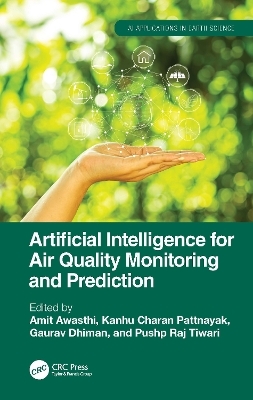
Artificial Intelligence for Air Quality Monitoring and Prediction
CRC Press (Verlag)
978-1-032-68379-9 (ISBN)
- Lieferbar (Termin unbekannt)
- Versandkostenfrei innerhalb Deutschlands
- Auch auf Rechnung
- Verfügbarkeit in der Filiale vor Ort prüfen
- Artikel merken
This book is a comprehensive overview of advancements in artificial intelligence (AI) and how it can be applied in the field of air quality management. It explains the linkage between conventional approaches used in air quality monitoring and AI techniques such as data collection and preprocessing, deep learning, machine vision, natural language processing, and ensemble methods. The integration of climate models and AI enables readers to understand the relationship between air quality and climate change. Different case studies demonstrate the application of various air monitoring and prediction methodologies and their effectiveness in addressing real-world air quality challenges.
Features
A thorough coverage of air quality monitoring and prediction techniques.
In-depth evaluation of cutting-edge AI techniques such as machine learning and deep learning.
Diverse global perspectives and approaches in air quality monitoring and prediction.
Practical insights and real-world case studies from different monitoring and prediction techniques.
Future directions and emerging trends in AI-driven air quality monitoring.
This is a great resource for professionals, researchers, and students interested in air quality management and control in the fields of environmental science and engineering, atmospheric science and meteorology, data science, and AI.
Amit Awasthi is Associate Professor at the University of Petroleum and Energy Studies, Dehradun, India. He completed his PhD at Thapar University, Patiala, in 2011, and has over 18 years of professional experience in the areas of research and development, teaching, and allied functions with reputed educational institutions and universities, offering research experience in atmosphere and environmental sciences including air monitoring, exposure studies, extreme events, water quality, climate change. He has the merit of receiving International Fellowship from National Science Council-Taiwan as Postdoc Fellow. He has published 4 textbooks and more than 60 research papers in reputed journals of atmospheric/environment sciences/climate change with an h-index 17 and citation ~ 1300 and impact factor ~200. He has received several research grants from national and international organizations in the areas of aerosol and water quality measurements. He has edited several books with reputed publishers such as Taylor & Francis, Elsevier, Springer. Kanhu Charan Pattnayak is Senior Climate Impact Scientist at the National Environmental Agency, Singapore, with over 17 years of experience in climate impact research and climate modeling. He has a Ph.D. in Climate Science from the Indian Institute of Technology Delhi and has held research positions at the University of Leeds, the National Environment Agency of Singapore, and the NCMRWF. He has published over 25 research papers in top-tier journals and has served as a reviewer for the Sixth Assessment Report of the United Nations Intergovernmental Panel on Climate Change. Gaurav Dhiman is Assistant Professor in the School of Sciences and Emerging Technologies at Jagat Guru Nanak Dev Punjab State Open University, Patiala, India. He holds a Ph.D. in Computer Engineering from Thapar Institute of Engineering & Technology, Patiala. He is recognized as one of the world's top researchers in Stanford University's list of the world's top 2% of scientists, prepared by Elsevier. He is a Senior Member at IEEE; Research Faculty at Lebanese American University, Lebanon; and Research Scientist at Universidad Internacional Iberoamericana, Mexico. He has authored over 300 peer-reviewed research papers and 10 books. He is currently serving as a guest editor for more than 40 special issues in various peer-reviewed journals. He is an Editor-in-Chief of the International Journal of Modern Research (IJMORE), and Co-Editor-in-Chief of the International Journal of Electronics and Communications Systems (IJECS) and International Journal of Ubiquitous Technology and Management (IJUTM). He is an Associate Editor of IEEE Transactions on Industrial Informatics, IET Software (Wiley), Expert Systems (Wiley), IEEE Systems, Man, and Cybernetics Magazine, Spatial Information Research (Springer), and more. Pushp Raj Tiwari is a climate scientist and Fellow of UK’s Higher Education Academy (FHEA), and specializes in climate change, big data, and earth system modelling. A former RCUK-ECR Fellow, he now leads a research group on Climate Change Modelling and Applications. His work focuses on aerosol-cloud–climate interaction and reducing the associated uncertainties related to them in climate models.
1. Air Quality Monitoring (AQM) and Prediction: Transitioning from Conventional to AI Techniques. 2. Temporal Variations of Sulphur Dioxide Levels across India: A Biennial Assessment (2020-2021). 3. The Effectiveness of Machine Learning Techniques in Enhancing Air Quality Prediction. 4. Enhancing Environmental Resilience: Precision in Air Quality Monitoring through AI-Driven Real-Time Systems. 5. Forecasting Air Pollution with Artificial Intelligence: Recent Advancements at Global Scale and Future Perspectives. 6. Integrating AI into Air Quality Monitoring: Precision and Progress. 7. Application of AI-based Tools in Air Pollution Study. 8. Study of Extreme Weather Events in the Central Himalayan Region through Machine Learning and Artificial Intelligence: A Case Study. 9. Machine Learning Applications in Air Quality Management and Policies. 10. A Glimpse into Tomorrow's Air: Leveraging PM 2.5 with FP Prophet as a Forecasting Model. 11. Air Quality Forecast using Machine Learning Algorithms. 12. Deep Learning Approaches in Air Quality Prediction. 13. Incorporation of AI with Conventional Monitoring Systems. 14. A Comparative Evaluation of AI-Based Methods and Traditional Approaches for Air Quality Monitoring: Analyzing Pros and Cons. 15. ML Driven Hydrogen Yield Prediction for Sustainable Environment.
| Erscheinungsdatum | 30.08.2024 |
|---|---|
| Reihe/Serie | AI Applications in Earth Science |
| Zusatzinfo | 27 Tables, black and white; 18 Line drawings, color; 40 Line drawings, black and white; 2 Halftones, black and white; 18 Illustrations, color; 42 Illustrations, black and white |
| Verlagsort | London |
| Sprache | englisch |
| Maße | 156 x 234 mm |
| Themenwelt | Informatik ► Theorie / Studium ► Künstliche Intelligenz / Robotik |
| Naturwissenschaften ► Geowissenschaften ► Geologie | |
| Naturwissenschaften ► Physik / Astronomie ► Angewandte Physik | |
| Technik ► Bauwesen | |
| Technik ► Umwelttechnik / Biotechnologie | |
| ISBN-10 | 1-032-68379-1 / 1032683791 |
| ISBN-13 | 978-1-032-68379-9 / 9781032683799 |
| Zustand | Neuware |
| Haben Sie eine Frage zum Produkt? |
aus dem Bereich


